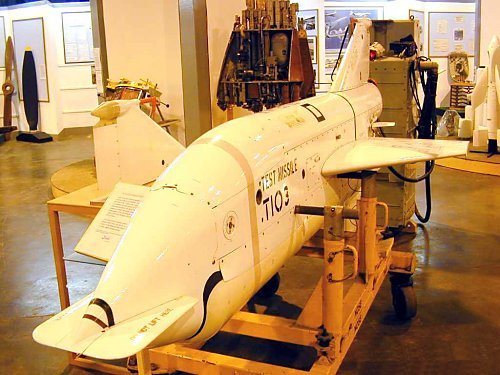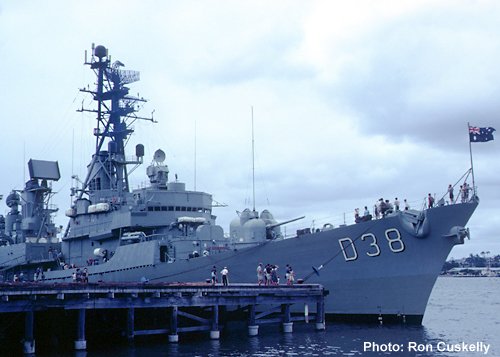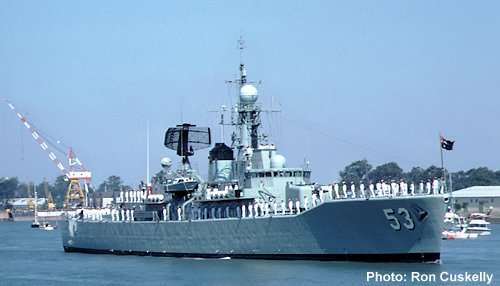![]()
IKARA and ADASTRAby Mike Wood |
|
An Ikara
missile preserved at Australia's Museum of Flight, Nowra.
|
|
The
Charles F. Adams class destroyer (DDG) HMAS Perth at Brisbane
in 1966.
(Photo: Ron Cuskelly) |
Preliminaries:
Adastra was
approached by the Royal Australian Navy and the Department of Supply in July 1967
with a request to quote for survey style photography of the Ikara sea trials.
Being a prestigious client it was an ideal contract to look to, and we were delighted
to win it.
To clarify operational details, including the security angle, Lionel Van Praag
and I were invited aboard HMAS Perth to meet the Navy team running the trials.
This was on 26th July when the ship was based in Sydney. At that time, 1967, Ikara
was in the top secret bracket and security was a concern to them.
The first trial was scheduled for 9th August, and to ease their minds in this
latter regard, we nominated as crew, three of our flight personnel who had been
commissioned RAAF aircrew, thus having ready clearance. The crew was Lionel, pilot,
Vic Petersen on camera and myself as navigator. (Later, after the company's bona
fides had been confirmed, security clearances were simplified, although we were
still subject to the Official Secrets Act.)
Cdr. Ike Wilson was the RAN director of the trials, and the Department of Supply's
representative was Malcolm Barrett. The latter, who retained that role for the
duration of the trials, was a most helpful liaison officer, and flew with us,
as observer, on several sorties.
First Trial:
On 8th August 1967, we took Hudson VH-AGP down to HMAS Albatross, a shore station at Naval Air Station Nowra, south of Sydney where we had a further briefing and later enjoyed the hospitality of the wardroom. However, this first trial ran into a series of problems, not only with the Ikara launch, but also with ship/aircraft communication, and when bad weather arrived the trial was scrubbed.
Aftermath and Second Trial:
Our debriefing
back at Adastra's base at Mascot led to some disquiet. We had flown seven sorties
over a four day period and there was concern over the amount of time that one
of our survey units had been committed to the work with no result. As it turned
out, however, in the long run, this initial trial proved its worth in that liaison
became smoother, many of the technical glitches were ironed out, and aborted trials
in the years ahead were often due to low cloud or a heavy sea state.
Lionel and I attended the Navy's debrief on 11th August at HMAS Rushcutter, the
naval depot. The client also expressed concern, and after a long meeting, decided
that more time was needed to solve their own problems.
On 17th November we were again invited to Rushcutter to what was labelled the
Sea Trials Conference. Although this was another lengthy affair, greater confidence
was evident and a second trial was set down for 13th December.
For the second trial (VH-AGX, same crew) we flew first to the RAN strip at Jervis
Bay and picked up as observer, Lt. Taff Hughes. Over three days, we again flew
seven sorties, but this time came back with positive photography, both colour
and black and white. Our client expressed complete satisfaction with the results
and we were assured of an on-going contract for the duration of the trials.
Summary of the Trials:
From that first, aborted attempt in August 1967 to the cessation of the trials in early 1974, Adastra provided survey coverage of the Ikara firings on at least 54 occasions. (This figure was arrived at from my diary entries. There were a few trials during my absence on field work which I didn't record.)
Aircraft Used:
|
Aircraft
|
Registration
|
Trials
|
| Hudson |
VH-AGP
|
1
|
| Hudson |
VH-AGX
|
4
|
| Cessna 206 |
VH-DGD
|
8
|
| Cessna 320 |
VH-DRK
|
2
|
| Hudson |
VH-AGJ
|
2
|
|
VH-AGU
|
10
|
|
| Aero Commander |
VH-AGA
|
5
|
| Cessna 185 |
VH-AGE
|
22
|
Pilots:
| Lionel Van Praag |
| Roy Williams |
| Brian Costello |
| Dave Brennan |
| Bruce Beale |
| Ron Pearce |
| Jock Head |
| John Messenger |
| John Collins |
| Dean Darcey |
Miscellany:
Trackers:
On a number
of the early trials we were advised by the control ship of a Grumman Tracker operating
in the firing zone, but at a safe altitude below us. What we discovered was that
the Tracker was also following the missile after launch. This intrigued Lionel
and me. But, as it transpired, any suspicions that the Navy boys were setting
up their own photographic unit were groundless.
Some years later, in June 1973, the Trackers again appeared in the firing zone.
We had been asked to prepare for a new style of two-day trials, one day to involve
infra red film for the standard Ikara firing, and day two to cover, with colour
film, a torpedo launch from a Tracker. There were six such trials that year. Once
again results were mixed, my notes indicating positive outcomes on only five days,
the remainder being spoilt by misfirings, rain or heavy sea state.
Cameras:
The camera
nominated by the client was the standard Wild RC8 with a 6 inch focal length lens.
At one of the RAN debriefings the problem of low cloud and the ensuing reduced
photographic coverage was discussed. This prompted me to suggest using the RC9
(focal length 3.5 inches). Perhaps because their plotting set up was based on
the 6 inch lens, they were reluctant to switch cameras. Further discussion led
to the idea of using the two cameras on the same trial. Of course our only aircraft
with dual camera hatches was the
Near Miss:
Earlier I mentioned technical glitches being ironed out. If this had been 100%, our contract would not have lasted the six or seven years that it did. Indeed, one memorable trial in March 1970 caused a deal of consternation. John Collins and I were in the Cessna 185 VH-AGE, and at launch, with camera rolling, we were just starting to follow the missile when its guidance system went awry. It doubled back on its track and splashed down dangerously close to the launch vessel. There was a sudden deathly silence on the airwaves and we stooged around awaiting instructions. Some time later, a subdued voice announced shut down of the trial and we headed home, but with the evidence of a genuine near miss.
Navy Hospitality:
We were always made welcome in the wardroom when overnighting at Albatross. This was an experience we all enjoyed, but probably more so by the younger members of our crew, who would have been new to the sometimes arcane traditions of an officers' mess. As our operations became routine, preflight briefings were more commonly held in Sydney and we found it expedient to obtain A.T.C. clearance at Mascot and fly directly to the firing zone. Thus, overnights at Albatross became infrequent.
Marker Dye:
Peter Shute's account (which follows) mentions the use of marker dye. My understanding of its purpose was to fix the splashdown point of the missile. Basic photogrammetry would then provide track and distance and confirm the accuracy or otherwise of the firing. On only one occasion of the 50 odd trilas I'd flown on, were we asked to help locate the torpedo, which was designed to surface at the end of its run. I assume it was tracked by a version of Asdic, and its recovery was routine.
Favoured Aircraft:
By far the
aircraft which featured most in the Ikara trials was the Cessna 185 VH-AGE. Naturally
it was more economical than a Hudson or the
Mike Wood
6th January 2004
IKARAby Peter Shute
Adastra's involvement in
the testing of the Royal Australian Navy's Ikara anti-submarine missile system
is another unusual task undertaken by the company. The Ikara system comprised
a torpedo hung under a missile launch vehicle. It was fired in the known direction
of a submarine and at a determined time the torpedo detached and descended under
a parachute. On entering the water, the parachute detached and the torpedo homed
on the target acoustically.
The following Ikara trials flights are recorded in Peter Shute's Log Book
|
||||||||||||||||||||||||||||||||||||||||||||||||||||||||||||||||||||||||||||||||||||||||||||||||||||||||||||||||
The Ikara Systemby Ron Cuskelly |
||||||||||||||||||||
|
The
HMAS Torrens sails up the Brisbane River during a Royal
visit in 1982.
(Photo: Ron Cuskelly) |
Ikara (Throwing Stick) was
an Australian designed anti-submarine missile system which could carry a Mark
44 torpedo to the vicinity of an enemy submarine. The torpedo would descend to
the sea by parachute and commence a spiral search pattern to locate the submarine
by acoustic means. Ikara was first fitted to the River Class frigate HMAS Stuart
which was commissioned in June 1965 and which featured prominently in the development
of the system. HMAS Derwent was fitted with Ikara in November 1965 and the system
was also fitted to HMAS Parramatta and HMAS Yarra during refits in 1967. HMAS
Swan and HMAS Torrens were equipped with Ikara while being built. The River class
frigates each carried one Ikara launcher. These vessels were redesignated as destroyer
escorts in 1969. The Ikara system was also fitted to the three Charles F. Adams
class destroyers (DDG) HMAS Perth, HMAS Brisbane and HMAS Hobart which each carried
two launchers. The system was also sold to the Royal Navy and the Brazilian Navy.
Ikara had been declared obsolete and removed from all three DDGs by 1991.
HMAS Perth, on which Adastra's involvement with Ikara began, was sunk as a dive
wreck off the coast of Albany, Western Australia on 24th November 2001.
HMAS Torrens (depicted above) was sunk off the coast from Perth, Western Australia
on 14th June 1999 in a much-publicised demonstration of a Mark 48 torpedo fired
by the submarine HMAS Farncomb.
|
IKARA
SPECIFICATIONS
|
|
| Prime Contractor | Australian Department of Manufacturing Industry. |
| Power | Dual thrust solid propellant rocket motor. |
| Guidance | Radio/Radar guidance/tracking system, receiving signals from automatic target prediction equipment on board the launch vessel. The missile is controlled via elevons. |
| Warhead | American Type 44 lightweight acoustical homing torpedo, or other types of torpedo. |
| Length | 11ft 0in (3.43m) |
| Wing Span | 5ft 0in (1.53m) Wings are quickly detachable for storage. |
| Maximum Speed | Subsonic. |
| Range | up to 11 miles (18km) |
|
Extracted
from "Missiles of the World" by Michael J.H. Taylor Ian Allan 1980 [ISBN
0 7110 0995 3]
|


